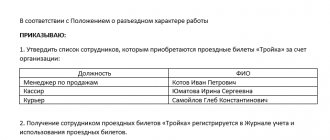Surely all parents are aware that up to a certain age the state guarantees children free travel on public transport. However, some nuances raise doubts and disputes. For example, is the baby required to sit? Does the conductor have the right to demand a document confirming the age of the child? How can a schoolchild or student purchase a travel card? Who is responsible if a child is injured during a trip?
- 2 Are supporting documents required
2.1 Additional benefits
- 4.1 Student travel card
- 5.1 If a child is injured in the subway
Until what age does a child have the right to travel for free?
According to Russian law, children under seven years of age have the right to travel freely on city public transport.
1. When traveling in a vehicle carrying out regular transportation of passengers and luggage, the passenger has the right:
1) carry with you free of charge in urban and suburban traffic children under the age of seven years without the provision of separate seats, except for the cases provided for in part 2 of this article;
2. In cases where, in accordance with the established procedure, the carriage of children in vehicles without providing them with separate seats is prohibited, the passenger has the right to transport with him two children under the age of twelve years with the provision of separate seats for them for a fee, the amount of which is not may be more than fifty percent of the freight charge.
Federal Law of November 8, 2007 N 259-FZ (as amended on October 30, 2018) “Charter of Road Transport and Urban Ground Electric Transport” Article 21. Transportation of children traveling with a passenger
https://base.garant.ru/12157005/b5dae26bebf2908c0e8dd3b8a66868fe/
According to Russian law, children under 7 years of age have the right to free travel on public transport.
The right not to buy a separate ticket for a child under seven years of age is associated with certain nuances:
- The benefit is provided specifically to the child, and not to his mother (father, grandmother, etc.). No matter who the child travels with, his travel is not paid.
- Such a child is not provided with a separate seat. Mom (or another accompanying adult) can take the baby on her lap. Another option is for the mother to seat her child while she stands nearby (she paid for her seat, after all). In addition, the child can simply stand holding the handrail.
- If a parent carries two children under the age of seven, he also does not pay for them (but only if the children do not occupy a separate seat). The little ones can again be placed on your lap, the two of them can sit on one seat (at this time the mother, who has paid for her fare, is standing), or the kids just stand.
According to the law, a parent can carry free of charge not only one child under 7 years old, but also more
- According to the law, a mother can carry more than two children under 7 years of age free of charge. Since it is simply unrealistic to seat them all on your lap or on one seat, some of them will have to stand, or the parent will have to pay for another seat so that the child can sit.
- If this vehicle does not provide for the transportation of passengers without a separate seat, then the mother will have to purchase a ticket for her child. An adult has the right to take with him two children under 12 years of age. In this case, a ticket for everyone will cost up to 50% of the full amount (this point is stipulated in Part 2 of Article 21 of the above law). It turns out, according to the law, for the third baby you will have to pay 100% of the cost of the trip.
Hello! Please tell me, does the conductor have the right to demand payment for travel (in city transport) for a child under 7 years old if he occupies 1 seat, and the parent rides standing?
Gagiev David, lawyer, Azov
No, the controller does not have the right to demand payment in such circumstances. The requirements of the law on payment and transportation of the child have been fulfilled; there are no clarifications on how transportation should be carried out in the charter of road transport and urban ground electric transport.
https://pravoved.ru/question/1909486/
Please tell me, when a passenger carries two children under seven years of age on public transport, payment for the second child is made in full or with a 50% discount. And how to interpret it.
Olga Fisak, lawyer, Murmansk
According to Federal Law dated November 8, 2007 N 259-FZ (as amended on July 3, 2016) “Charter of Road Transport and Urban Ground Electric Transport” Article 21, you have the right to transport children without providing a separate seat. But if a second child takes a seat (for example, you seated him next to you), then payment must be made for one child and for your seat.
https://pravoved.ru/question/1909486/
Fringe benefits
Additional benefits that allow you to move around the city for free are provided for:
- Disabled children.
- Children from large families.
- Orphans or children without parental care.
- Teenagers from families without a breadwinner.
No benefits apply to taxis, as this is a private type of transportation.
In order to be entitled to the benefit for long-distance departures, you will have to obtain the appropriate status. You should contact the social security authority with a package of documents and receive a special paper there that gives you the right to free travel on the bus, metro, tram and trolleybuses. This opportunity is assigned to a person until he reaches the age of majority, or until he is twenty-three years old if he is a full-time university student.
Are supporting documents required?
The conductor has the right to demand from the parent (or other accompanying adult) a document confirming the age of the child. Of course, if the child is very small, such a problem may not arise, but if the age of the young passenger is already approaching 7 years, or the baby looks older than his age, then this is quite likely.
Many mothers and fathers in such a situation begin to be indignant (after all, “everyone already knows about the benefit”). They are wrong. The already mentioned Article 21 of the Transport Charter gives the conductor the authority to check the rights of benefit passengers. Therefore, he must make sure that the baby is not yet seven years old by looking at his birth certificate. The accompanying adult is required to carry the original of this document with him (alternatively a photocopy of it or a parent’s passport with a note about the child’s birth) and present it if necessary.
3. The passenger is required to have with him a document that confirms the age of the child transported with the benefits of the fare specified in parts 1 and 2 of this article, and which must be presented upon the first request of the persons monitoring the fare.
Federal Law of November 8, 2007 N 259-FZ (as amended on October 30, 2018) “Charter of Road Transport and Urban Ground Electric Transport” Article 21. Transportation of children traveling with a passenger
https://base.garant.ru/12157005/b5dae26bebf2908c0e8dd3b8a66868fe/
Accordingly, if a parent refuses to present the child’s birth certificate to the conductor, then he is obliged to pay 100% of the fare for his child.
Rules for organized transportation of groups
Organized transportation of children means travel on a transport bus for a group of eight or more small passengers without parents or other legal representatives. There are no age restrictions in the norms.
Only buses that have been in operation for no more than ten years and are fully intended to transport passengers are allowed to transport children. It must be driven by a person with continuous experience of one year and with a category “D” driver’s license, who has not had any administrative offenses in the last year that would result in deprivation of rights. Before leaving, he must listen to instructions on transporting children.
The bus has a special identification sign in the form of a yellow square: “Transportation of children.” The bus should travel no more than 60 km/h. There is also a mandatory “Speed Limit” sign on the back of the bus.
Before leaving, a notification is submitted to the regional traffic police department.
Cases of full payment of travel and at a reduced rate according to the rules
If the child is already 7 years old and does not fall under the preferential category, then he is obliged to pay 100% for the trip in transport. Naturally, he has the right to occupy a seat (provided that there is a free one), including if the boy or girl is traveling independently (without adults). If the transport seats are occupied for passengers with children, disabled people and pregnant women, the conductor may ask you to give up your seat to a child (if he, of course, does not look very old). But ask for five, but not demand (this was discussed earlier).
If the child is over 7 years old, then he is required to purchase a ticket for public transport (with the exception of preferential categories of children)
The preferential rate of payment (not more than 50%) has already been noted earlier - if a child under 12 years of age travels with a parent in transport where there are only seats (standing is prohibited). For example, it could be a bus or a minibus, where seat belts are required. There are no references to specific regulations in this regard in the Motor Transport Charter, but they can be found in other regulations, namely, in paragraph 5.1 of the traffic rules.
5.1. Passengers are required to: when traveling in a vehicle equipped with seat belts, be wearing them, and when riding a motorcycle, wear a fastened motorcycle helmet;
Traffic rules - traffic rules 2021 New traffic rules with changes from December 21, 2021.
https://pddmaster.ru/documents/pdd/5-pdd
To find out which buses must be equipped with seat belts, you should refer to another document.
18) Vehicles of categories M1, N, as well as M2 and M3 of classes III and B are equipped with seat belts. The remaining vehicles of categories M2, M3 are equipped with seat belts if they are used to transport passengers in intercity traffic.
Decision of the Customs Union Commission dated December 9, 2011 N 877 “On the adoption of the technical regulations of the Customs Union “On the safety of wheeled vehicles” With amendments and additions dated: January 30, 2013, December 2, 2014, May 28, October 14, 2015 June 7, July 11, 2021, February 16, December 25, 2018, June 21, 2021 Appendix No. 2
https://base.garant.ru/70106658/
Here you need to decrypt:
- Category M1 Vehicles used for the transport of passengers and having, in addition to the driver’s seat, no more than eight seats - passenger cars.
- Category M2 - Vehicles used for the transport of passengers, having, in addition to the driver's seat, more than eight seats, the technically permissible maximum weight of which does not exceed 5 tons.
- Category M3 - Vehicles used for the transport of passengers, having, in addition to the driver's seat, more than eight seats, the technically permissible maximum weight of which exceeds 5 tons.
- Category N - Vehicles used for the transportation of goods - trucks and their chassis.
The question regarding private minibuses should be clarified. Some of them have “No Standing” signs inside. However, this does not mean that the mother will pay 50% of the ticket price for her child. You will have to pay in full, since this is private, not municipal transport.
How can the inspector determine the age of the child?
Parts 7 and 11 of Article 20 of the Federal Law:
7. The procedure for confirmation by a passenger of payment for travel, transportation of children traveling with him, in cases where his travel or transportation of children is subject to payment, including the provision of benefits in terms of carriage fare specified in parts 1 and 2 of Article 21 of this Federal Law, transportation of baggage, carriage of hand luggage, as well as confirmation by the passenger of the right to free or discounted travel when traveling along regular transport routes in urban, suburban and intercity traffic, the following is established: ... 11. A passenger entitled to free or discounted travel is required to have with him and present, in the manner established in accordance with Part 7 of this article, at the request of a representative of the carrier and (or) an official authorized to verify payment confirmation, a document confirming the right to free or discounted travel, and an identification document of the passenger in accordance with legislation of the Russian Federation. If a document confirming the right to free or discounted travel contains a photograph of its owner, presentation of an identification document in accordance with the legislation of the Russian Federation is not required.
Thus, the passenger must independently confirm the age of the child, for which he should take with him a birth certificate .
If the inspector has doubts about the age of the baby, he will ask to present the specified document. If the passenger does not have the document, then the fare will have to be paid in full.
Travel cards for schoolchildren and students
If a student has to get to school by public transport, especially with transfers, it makes sense to buy him a travel ticket.
If a child gets to school by public transport, it is more profitable for him to purchase a school travel card
In different regions, the conditions for obtaining a travel card and the specific amount of the discount on travel (compared to an adult travel card) may vary significantly. After all, the issuance and implementation of these documents is regulated by local authorities. On average, we can talk about a discount of about 50%.
Where to go regarding rights violations
There are unforeseen cases when the driver does not react in any way to a report of an injury and continues driving. According to the law, this unprofessional behavior can be equated to the situation of leaving the scene of an accident (Part 2 of Article 12.27 of the Code of Administrative Offenses of the Russian Federation): “Code of the Russian Federation on Administrative Offenses” dated December 30, 2001 N 195-FZ (as amended on August 2, 2019) . and additional., entered into force on September 1, 2019) This is subject to arrest for up to 15 days or deprivation of rights for a period of 1–1.5 years.
Of course, in this case it will not be possible to call the police to the scene of the incident. Therefore, parents need to find information about the insurance company in the transport (write it down or take a photograph), the driver’s last name, vehicle number, telephone numbers and names of witnesses. Again, you should save the ticket and go to a medical facility so that the child’s injuries can be recorded.
Of course, if a child travels alone, he will most likely get confused and not do all this. Therefore, adults at home should find information about the insurer on the Internet on the carrier’s website.
Next, the parents submit an application to the insurance company with the available documents for compensation not only for health damage, but also for moral compensation.








